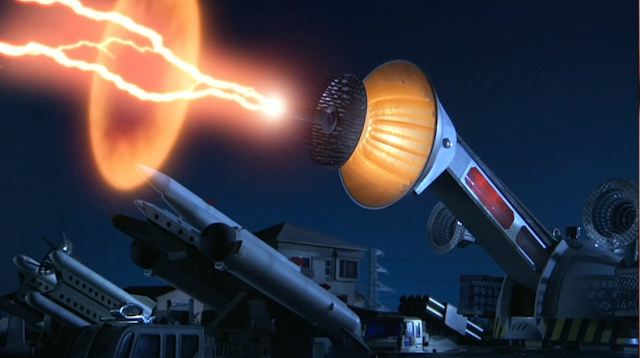 Here's where this site finally does the world a public service. Despite all you may have heard about the infamous CALIGULA, I'm here to tell you that's it's an overblown testament to across-the-board excess, turgidly dull, and certainly not worth the waste of two-and-a-half hours of your life. It even stars my favorite actor, Malcolm (A CLOCKWORK ORANGE) McDowell, and I still can't stand it! I mean, how do you make a movie so absolutely loaded to the gills with extremely graphic gore and hardcore sex — two elements I adore — and still have it turn out so fucking boring?
Here's where this site finally does the world a public service. Despite all you may have heard about the infamous CALIGULA, I'm here to tell you that's it's an overblown testament to across-the-board excess, turgidly dull, and certainly not worth the waste of two-and-a-half hours of your life. It even stars my favorite actor, Malcolm (A CLOCKWORK ORANGE) McDowell, and I still can't stand it! I mean, how do you make a movie so absolutely loaded to the gills with extremely graphic gore and hardcore sex — two elements I adore — and still have it turn out so fucking boring?
The film has no real story — no surprise since the script was penned by that pretentious and overrated A-hole Gore (MYRA BRECKENRIDGE) Vidal — and is just an escalating parade of explicit images that seek to titillate the viewer, and as such it could be considered a success, provided you're just looking for entrails and pussy, but the whole in-your-face experience is simply numbing after its all-too-generous running time. The film also famously roped a slew of A-list thesps to appear in what was originally to be an R-rated look at the mad emperor's rule and eventual assassination, but then money man Bob "Penthouse" Guccione, aided by his pal Giancarlo Lui, shot and inserted majorly-explicit sex stuff while the film was in post-production that pissed off many of the cast and alienated many critics, to say nothing of presumably annoying the piss out of the porno audience who wanted to see just the wet shots with no attempt at anything else. I've seen porn audiences who don't care if a given skin flick is shot in a moldy basement while the talent fuck on a stained mattress just as long as there's action, which CALIGULA certainly has, but it's trying to be way too highbrow while also striving to appeal to the trenchcoat brigade, and that's a recipe that just doesn't work.
The only positive things I have to say about the film are few, but they are strong draws to the curious, so let me break it down for you:
- The sets, costumes, and other related stuff are just as opulent as anything found in the historical epics of decades past, so even if the movie itself is largely boring, you can at least enjoy the pretty images.
- The film barely goes for two or three minutes without something pornographic or violent happening, and the nudity/sex ranges from simple nekkid chicks to full-blown orgies of flesh featuring scores of humpers, complete with the camera practically shoved up every nearby orifice.
- One of my favorite actors, Helen (PRIME SUSPECT) Mirren, is in CALIGULA, and she does get nekkid.
 Not that she's ever been shy, but I'm just saying. She even has a three-way with Caligula and his sister (that's Helen with the long-assed wig.)
Not that she's ever been shy, but I'm just saying. She even has a three-way with Caligula and his sister (that's Helen with the long-assed wig.)
 However, I'm only noting that scene because it exists, not because it's all that hot.
However, I'm only noting that scene because it exists, not because it's all that hot.
- My man Malcolm McDowell gives perhaps his most over-the-top performance here, and that's really saying something. I love the guy and it's a joy to see him chew the scenery with that patented loony smirk upon his face while wearing an assortment of staggeringly flamboyant togas.
 But the one thing, — THE ONE THING!!! — that keeps CALIGULA in my DVD collection is the contribution of Lori Wagner and Anneka di Lorenzo, two lovelies who are featured as regulars in Cal's live-in entourage. These benevolent goddesses make the entire film worth sitting through thanks to what is, in my humble opinion, the greatest hardcore lesbian scene ever committed to celluloid.
But the one thing, — THE ONE THING!!! — that keeps CALIGULA in my DVD collection is the contribution of Lori Wagner and Anneka di Lorenzo, two lovelies who are featured as regulars in Cal's live-in entourage. These benevolent goddesses make the entire film worth sitting through thanks to what is, in my humble opinion, the greatest hardcore lesbian scene ever committed to celluloid.
Their scene is interspersed as counterpoint with the aforementioned three-way and in every way their bedroom arabesque blows the competition out of the water. Incredibly sensual, tender, and downright steamy, the sequence is commanded by Anneka di Lorenzo, who claims in the unimaginably boring making-of documentary to have never previously had sex with another woman... Well, all I have to say to that claim is, "Yeah, RIGHT!" The girl eats clam like a goddamned sea otter and it's truly a joy to behold. I usually find lesbian scenes, even the hardcore ones, boring as shit, but this sequence is an exception of unparalleled magnitude.
The only thing that stops it from being absolutely perfect is the cutting back and forth to Cal's listless threesome, and its relative brevity. Any fool could have seen that the Wagner-di Lorenzo segment was a winner, so why did Guccione fuck it up with intercut hetero stuff? Surely the man was mad.
So now you know all you need to know about CALIGULA, and you can proceed at your own risk. But I'm tellin' ya, that lesbian scene...WOOF!!!













































